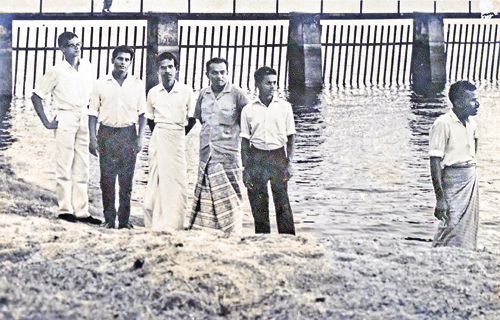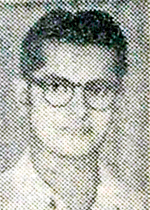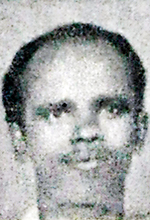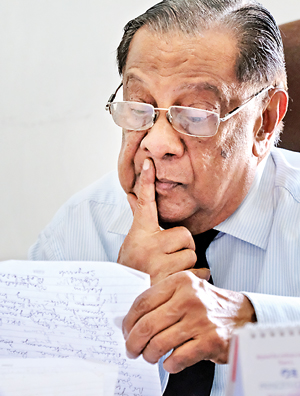Enter two ‘saronged johnnies’

Sergeant M.H.P. Fernando (third from right) in Anuradhapura on undercover work during the floods
No one would have cast a second glance at them, seemingly two ‘saronged johnnies’, having a cup of tea in a shop at the Kada Panaha in the New Town or haunting the market in the Old Town like hangers-on found around Anuradhapura those days looking for odd-jobs.
What no one suspected was that they were two undercover policemen in civvies from the Criminal Investigation Department (CID) in Colombo, keeping a close ear to the ground, amidst the floods of that time, for any bits of information.
They were Sergeant Merendhege Henry Peter Fernando fondly called “Batha” Fernando and Constable J.M. Piyasena whose ‘sniffer’ work led to the cracking of the tight shell of secrecy around the Kalattawa double murders and sealed the fate of tavern owner and big-time irrigation contractor Alfred de Zoysa and his accomplices W. Piyadasa alias Kalu Albert and W. Fernando alias Willie Mama.
It is not only about the major breakthrough but also what happened behind the impenetrable façade of the CID that we learn from then Inspector Upali Seneviratne.
Strong links Mr. Seneviratne too had with the CID probe, for it was he who, along with a murder victim’s son, walked the byways of the Pettah in search of ‘claw-like’ buckles, for the main murder clue unearthed at Kalattawa was such a buckle, with the belt burnt to ashes.

Julius Sandra-sagara: No trace of his body
Ultimately, Alfred de Zoysa was found guilty of committing the murder of Peduru Kankanamalage David (P.K.D.) Perera and he along with Kalu Albert and Willie Mama was also found guilty of conspiracy to murder Perera.
All three were found guilty in a jury-trial in May 1970 and later sentenced to death. After losing their appeals, Zoysa and Kalu Albert were hanged in 1972, while Willie Mama died in prison.
Zoysa was found not guilty of conspiracy to murder and committing the murder of Julius Sandrasagara and Kalu Albert and Willie Mama were found not guilty of the conspiracy to murder Sandrasagara.
Very clear details about Perera and Sandrasagara come from Mr. Seneviratne who explains that Perera had been a mechanic of the Irrigation Department at its Ratmalana workshop. Zoysa, being a contractor for the department would have been in and out of the workshop and that is how he would have come into contact with Perera. After retirement, Perera had gone into Zoysa’s employment.
“Perera who lived in Talangama was married to Sopi Nona and they had 10 children, five boys and five girls,” says Mr. Seneviratne. They were P.K.C. Perera, Jayasili, Charles, Sumanadasa, Malini, Lionel, Chandralatha, Ratnadasa, Milton and Siriyalatha.
It was Sumanadasa, a minor employee at the Angoda Mental Hospital, who accompanied Mr. Seneviratne to Pettah to find a belt similar to the one worn by his father. “We did find it,” smiles Mr. Seneviratne, adding that Perera would have fallen foul of Zoysa because he had blabbed about the whereabouts of the Austin Cambridge stolen from All-Ceylon cricketer C.I. Gunasekara to Sopi Nona and some relatives.

Kalu Albert
Sandrasagara, meanwhile, had been a technical officer at the Irrigation Department. He was divorced. While working at the Batticaloa workshop that he was interdicted over some misdemeanour and was living with his mother in Kotahena.
The complicated pieces of the jigsaw puzzle of murder that occurred in 1966, more than 50 years ago, fall into place.
After the robbery of the vehicle and cash from the tavern tenderer, S.R. Kandiah and his men who came from the north and were waylaid on their return journey at the Boo Oya bridge along the Medawachchiya-Vavuniya Road, the sleepy town of Anuradhapura began “hotting” up.
Kalattawa, owned by Zoysa, was raided by the Anuradhapura Police, for it was the location of a huge illicit distillery. The suspicion of who leaked the information to the police fell on Perera and Sandrasagara who had had some disagreements with Zoysa and left his employ.
It was 12.30 p.m. on November 6, 1966, when Sandrasagara walked into the 4th Floor of the CID. He did so because his classmate at St. Benedict’s College, Kotahena, was Inspector (IP) L.S. (Shelley) Salvador who was in charge of the Aliens’ Branch coming under the CID’s Special Branch, says Mr. Seneviratne, who gives us the layout of the CID – the 4th Floor was occupied by the Investigation Branch and the corner room by the Aliens’ Branch (which investigated matters linked to foreigners).

Upali Seneviratne:Recollecting a murder most foul. Pic by Amila Gamage
IP Salvador recorded Sandrasagara’s statement which included the details of the waylaying and robbery of the Jaffna renters by Zoysa’s men and also about his illicit liquor operations. The statement given by Sandrasagara was sent to IP Salvador’s superior Assistant Superintendent of Police (ASP) S.K. Chandrasekara who passed it onto SP Lionel Senanayake in charge of the Special Branch.
Following up on the information, a CID team visited Sandrasagara’s 64-year-old mother at Kotahena and got into its possession two letters from Sandrasagara to her about his job under Zoysa and how he was unhappy and also that Zoysa was not paying him his wages.
The team also found evidence that the person running the Hollywood Bar in Mutwal, owned by Zoysa, was his ‘odd-job man’ and had persuaded Sandrasagara to get back to work under Zoysa.
“The ulterior motive, of course, would have been to lure Sandrasagara back,” says Mr. Seneviratne, adding that then Senior Crown Counsel of the Attorney-General’s Department, Ian Wikramanayake (who would later become a powerful force as Bribery Commissioner under Justice Minister Felix Dias Bandaranaike in the 1970s) was also Sandrasagara’s classmate and provided a statement.
The investigation gathered further momentum when a spate of anonymous petitions was sent to the Deputy Inspector General (DIG) Northern Range, Aleric Abeygunawardena under whom was Anuradhapura. These petitions were then forwarded to CID SP Tyrrell Goonetilleke.
Soon after that Sergeant ‘Batha’ Fernando (called Batha because at one time he had run the police mess) and PC Piyasena were dispatched to Anuradhapura, roaming around the area in late 1966 and early ’67.
Bit by bit they gathered the information, with a rendezvous in the jungles of Rambewa on the Kandy-Jaffna Road, cracking the case.
February 22, 1967 at 1 p.m., the CID duo had met informant Hettiarachchige Don Juvan Appuhamy (39), a tractor driver, who was in the know about the nefarious activities of Zoysa.
In his hut at the 6th Milepost, he spilled the beans about where the stolen Austin Cambridge was buried.
Hurrying back to Anuradhapura, Sergeant Fernando and PC Piyasena were at the bungalow of the Assistant Superintendent of Police (ASP), A. Mahendran at 7.30 p.m. to produce Appuhamy’s statement.
Things happened quickly thereafter, with the two-member CID team being instructed by CID SP J.A.A. Selvaratnam at 10.30 p.m. to contact the SP of the North Central Division (NCD), C. Dhanapala, who met them the next morning at 10 a.m. at his office and instructed them to be present at a police conference being summoned at 1 p.m.
The conference was attended by NCD SP Dhanapala; Anuradhapura ASP Mahendran; Anuradhapura Officer-in-Charge (OIC) of Crimes, S.S. Navaratnaraja; and Medawachchiya OIC Nalin Delgoda.
“Appuhamy knew where the stolen Austin Cambridge was buried because he helped push the car into the pit, along with three others, including Wilson alias Vincent, who had been part of the car burial team. Wilson was to be bumped off at Oddusudan, Mullaitivu at one of Zoysa’s work sites to hush-up the car-robbery,” says Mr. Seneviratne, adding that Mr. Navaratnaraja and Mr. Delgoda intercepted Wilson and brought him to Kalattawa while also arresting Zoysa in Anuradhapura.
In Kalattawa, with the CID getting an excavator from the Irrigation Department, there had been a time of suspense when Wilson was totally confused, as the scene had undergone change with a paddyfield being there. But they did unearth the car.
“When Mr. Navaratnaraja went for Zoysa to his house, he had run into his neighbour’s home and hidden under a bed there,” says Mr. Seneviratne, adding that he was taken into custody and brought to Kalattawa when the car was raised from its pit.
Mr. Seneviratne recalls how Zoysa had been relaxed at Kalattawa, sipping a hot drink arrogantly, until the car was unearthed.
The CID Officers who played a crucial role in the Zoysa probe were Senior IP M.K.J. Perera (‘Captain’ of the team); IP Gamini Weerasinghe; IP C. Sumanasekara; IP D.B.A. Perera; IP G. Ratnanayagam; and IP D.J. Nathaniels, all who are no more; IP Vere de Alwis (now in Australia); IP P.B.J. Aluvihare (now in America); IP Terry Amarasekara (living in Dehiwela); and Mr. Seneviratne who lives in Kandana.
| Solving a crime with a missing body | |
| The Kalattawa double murder case was “sensational”, says Mr. Upali Seneviratne, pointing out that it was the “one and only” case in Sri Lanka and the “second” in the world at that time, where there was no body. There was no corpus delicti, which means that there was no concrete evidence of a crime such as a corpse. For there were only bone fragments, a belt buckle and the frame of a bag, he says. “The bone fragments were of P.K.D. Perera but we never found Julius Sandrasagara’s body even though we literally dug up the whole of Anuradhapura.” According to Mr. Seneviratne the only eye witness to the murder of P.K.D. Perera was Punchi Bandage Jayasena who was about 18 years old. He had been at the wadiya in Kalattawa when Perera was brought by Zoysa and Kalu Albert and Willie Mama had made him drunk. They had then assaulted him, blown off the Petromax lamp plunging the area into darkness, run him over with a tractor driven by Kalu Albert, poured two cans of petrol over his body and set it on fire. The most difficult task, which Mr. Seneviratne calls “Herculean”, was to protect these vital witnesses, Wilson (who was part of the car burial team) and Jayasena. It had been carried out by Sergeants Weerawardena and Sediris, while Jayasena’s statement had been recorded by IP Gamini Weerasinghe. The key expert witnesses whose evidence swung the verdict in the case were Professor of Anatomy, Prof. Lester Jayawardane; Colombo Judicial Medical Officer (JMO), Dr. W.D.L. Fernando; and Government Analyst, C. Coomaraswamy. While Wilson was sent into hiding in a colony in Kantale, Jayasena the “only” witness to Perera’s murder who had received many death threats had been found employment in a boutique in Ratnapura. To complicate the lives of the investigators, Jayasena had got embroiled in another case, when he playfully threw a firebrand at a co-worker which had hit him on the head, killing him. It was a clear case of culpable homicide not amounting to murder and he was in custody when he gave evidence in the Kalattawa case, says Mr. Seneviratne, adding that the seven jurors were also kept under close surveillance.
|
| Plots within main plot | |
| Many are the plots within the main chilling plot of these murders most foul. Detailing the saga of the stolen car, Mr. Upali Seneviratne says that cricketer C.I. Gunasekara’s grey Austin Cambridge (2 Sri 3081) was stolen from his home along Vajira Road, Bambalapitiya, by a gang of seven Island Reconvicted Criminals (IRCs) who were very much in cahoots with Alfred de Zoysa. The car was delivered to Zoysa in Anuradhapura who paid off the robbers and brazenly drove around in it, after eliminating the last digit on the number plate. However, that was not the end of this plot – after some time the IRCs had used the Austin Cambridge to waylay a cooperative manager transporting Rs. 11,000 to the bank in Dompe and a Ja-ela tavern owner of Rs. 10,000 in Divulapitiya. The modus operandi not only in these two robberies but also at the Boo-Oya bridge were the same – intercepted, shots fired and cash robbed, points out Mr. Seneviratne, adding that the IRC gang comprised Jayewardena from Gampaha, Joseph Anthony Nonis alias Kochchi Josha from Ja-ela, Nelson from Kirindiwela, Seneviratne from Kirillawala, Ariyadasa from Thimbirigasyaya, Jayalath from Ragama and Nicholas from Hettigama.
|


